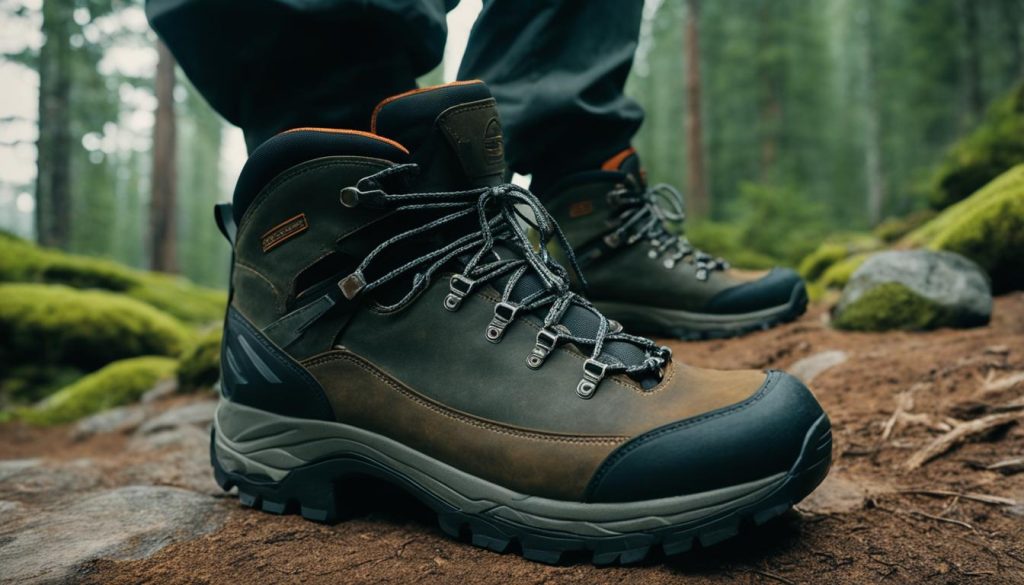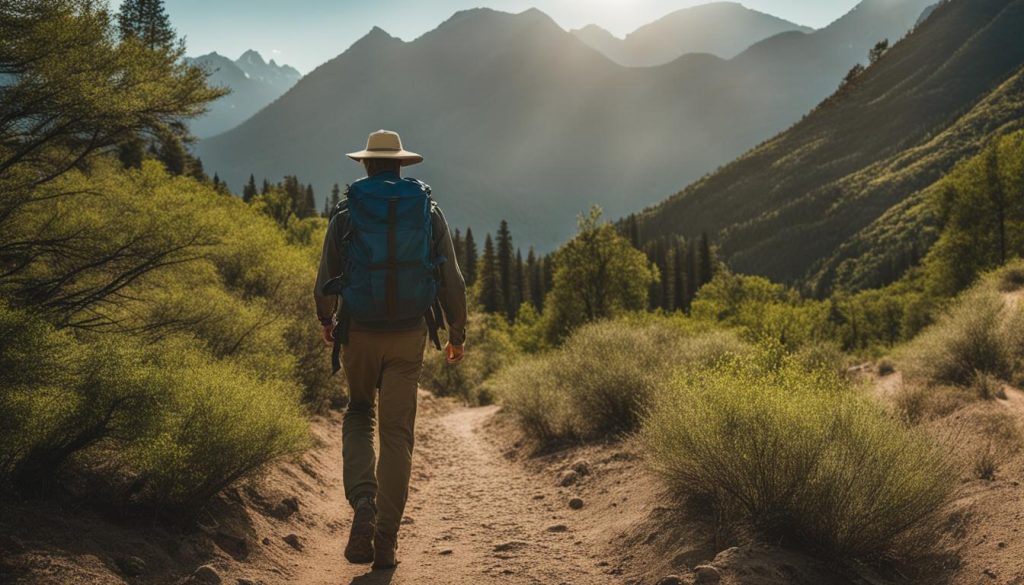Are you ready to hit the trails? Whether you’re a seasoned hiker or just starting out, having the right gear is essential for a successful and enjoyable hiking adventure. From sturdy footwear to navigation tools, we’ve compiled a list of the top 10 must-have items that every hiker should have in their arsenal.
Hiking essentials can vary depending on the length and difficulty of your hike, but there are a few key items that should always be on your gear list. These essentials will not only ensure your safety but also enhance your overall hiking experience.

Key Takeaways:
- Invest in proper footwear that offers support and traction for different terrains.
- Carry a reliable map, compass, or GPS device for navigation.
- Pack enough water and nutritious snacks to stay hydrated and fueled.
- Wear moisture-wicking and layerable clothing for comfort and protection.
- Include essential safety gear like a first aid kit and emergency shelter.
Embarking on a hiking adventure is a great way to connect with nature and challenge yourself physically. By equipping yourself with the essential hiking gear, you’ll be well-prepared to tackle the trails with confidence. So, pack your must-haves and get ready to explore the great outdoors!
The Essential Hiking Gear Checklist
When it comes to embarking on a hiking adventure, having the right gear can make all the difference. Whether you’re a seasoned hiker or just starting out, having the essential outdoor equipment is crucial for a successful and enjoyable experience. In this section, we will explore the best hiking gear options available in the market and provide you with a comprehensive hiking equipment checklist.
Footwear
Sturdy and comfortable footwear is the foundation of a successful hiking trip. Look for hiking boots or shoes that provide ankle support, have a durable outsole for traction on various terrains, and offer waterproof protection. Choose a pair that fits well and provides ample cushioning to keep your feet comfortable throughout the journey.
Navigation Tools
Getting lost in the wilderness is the last thing you want during a hike. Ensure you have the necessary navigation tools to stay on track. Consider investing in a reliable compass or handheld GPS device to help you navigate through unfamiliar trails. Additionally, having a detailed map of the area is essential for planning your route and understanding the terrain.
Backpack
A well-fitted backpack is essential for carrying all your hiking gear and supplies. Look for a backpack that offers ample storage space, multiple compartments for organization, and adjustable straps for a comfortable fit. Consider the size and capacity of the backpack based on the duration of your hike and the amount of gear you’ll be carrying.
Apparel
Choosing the right clothing for your hike is vital for comfort and protection. Opt for moisture-wicking and quick-drying fabrics to keep you dry and comfortable throughout the journey. Layering is key in outdoor adventures, so pack lightweight base layers, insulating mid-layers, and a waterproof outer shell. Don’t forget to bring a hat, sunglasses, and sunscreen for sun protection.
Shelter
Having a reliable shelter is essential for overnight hiking trips or unexpected weather changes. Consider carrying a lightweight tent or a hammock system if you prefer minimalistic camping. Ensure your shelter is durable, easy to set up, and provides adequate protection from the elements.
Hydration System
Staying hydrated is crucial during a hike to maintain energy levels and prevent dehydration. Invest in a hydration system such as a hydration bladder or water bottles with built-in filters. Consider the duration of your hike and the availability of water sources when planning how much water to carry.
Other Essentials
In addition to the essential gear mentioned above, there are a few other items you should have on your hiking equipment checklist:
- Headlamp or flashlight for visibility during early morning or late-night hikes.
- Multi-tool for various tasks and repairs on the trail.
- First aid kit to handle minor injuries and emergencies.
- Snacks and food to fuel your body during the hike.
- Insect repellent to protect yourself from pesky bugs.
- Sun protection such as sunblock and lip balm.
- Emergency whistle to signal for help in case of an emergency.
By ensuring you have the right outdoor equipment and the best hiking gear, you can embark on your next hiking adventure with confidence. Use the checklist above to prepare for your trip and have a memorable experience in the great outdoors!
| Category | Essential Gear |
|---|---|
| Footwear | Hiking boots or shoes |
| Navigation | Compass or handheld GPS device, detailed map |
| Backpack | Well-fitted backpack with ample storage |
| Apparel | Moisture-wicking layers, waterproof outer shell |
| Shelter | Tent or hammock system |
| Hydration | Hydration bladder or water bottles with filters |
| Other Essentials | Headlamp or flashlight, multi-tool, first aid kit, snacks and food, insect repellent, sun protection, emergency whistle |
Clothing and Footwear
When it comes to hiking, selecting the right clothing and footwear is essential for a comfortable and enjoyable adventure. The right gear can protect you from the elements, prevent blisters, and keep you comfortable throughout your journey. Here are some key items to consider adding to your hiking essentials:
Hiking Apparel
Investing in moisture-wicking layers is crucial for regulating body temperature and keeping you dry during strenuous hikes. Look for clothing made from high-performance fabrics such as merino wool or synthetic materials that offer breathability and quick-drying properties.
Avoid cotton clothing as it retains moisture and can lead to discomfort and chafing.
“Investing in moisture-wicking layers is crucial for regulating body temperature and keeping you dry during strenuous hikes.”
Proper Footwear
Your choice of footwear can make or break your hiking experience. Prioritize investing in a pair of durable hiking boots that provide ankle support, traction, and protection against rocks and debris.
Ensure your boots are well-fitted and broken in before embarking on a long hike to avoid blisters and discomfort. Consider the terrain you’ll be venturing into, whether it’s rocky, muddy, or steep, and choose footwear that suits the conditions.
Don’t forget about moisture-wicking socks made from materials such as merino wool or synthetic blends. These socks help prevent blisters and keep your feet dry throughout your hike.
Hiking Gear List: Clothing and Footwear
Here’s a comprehensive list of essential clothing and footwear items to include in your hiking gear:
| Item | Description |
|---|---|
| Hiking Boots | Durable, waterproof, and ankle-supportive boots for hiking |
| Moisture-Wicking Layers | Shirts, pants, and thermal layers made from quick-drying fabrics |
| Moisture-Wicking Socks | High-performance socks to keep feet dry and prevent blisters |
| Hiking Pants/Shorts | Durable and comfortable pants or shorts designed for hiking |
| Protective Outerwear | Waterproof jacket and pants for protection against rain and wind |
| Layering Pieces | Lightweight jackets, fleece sweaters, or vests for added warmth |
| Hat | Wide-brimmed or beanie for sun protection or warmth |
| Gloves | Insulated gloves or mittens for cold weather |
| Gaiters | Protective covers for ankles and lower legs to keep dirt and debris out |
Remember, your comfort and safety are paramount when it comes to clothing and footwear for hiking. Invest in high-quality gear that suits your needs and the environmental conditions you’ll encounter. With the right clothing and footwear, you’ll be well-prepared to tackle any trail that comes your way.
Navigation and Safety Gear
When embarking on a hiking adventure, it is crucial to prioritize your safety and well-being. To ensure a smooth and secure journey, equipping yourself with essential navigation and safety gear is a must. Whether you are traversing through well-marked trails or venturing into uncharted territory, these gear items will provide you with the confidence and preparedness needed for any situation.
1. Reliable Compass
Never underestimate the power of a reliable compass. This vital navigational tool will guide you through unfamiliar terrain and help you stay on track. Don’t solely rely on your smartphone’s compass app, as it may not function properly in remote areas with limited connectivity. Invest in a high-quality compass designed specifically for outdoor adventures.
2. Detailed Map
A detailed map of the area you plan to hike is an absolute necessity. It will assist you in plotting your route, identifying landmarks, and understanding the topography. Ensure the map is up to date and waterproof to withstand unexpected weather conditions.
3. Headlamp or Flashlight
Never underestimate the importance of a reliable source of light when hiking, especially if you plan to explore during the early morning hours or after sunset. A headlamp or flashlight will illuminate your path and help you navigate safely, particularly in areas with low visibility or challenging terrain.
4. First Aid Kit
Accidents and injuries can happen while hiking, so it’s essential to carry a well-equipped first aid kit. Your kit should include basic supplies such as bandages, adhesive tape, wound dressings, antiseptic wipes, and pain relievers. Familiarize yourself with the contents of the kit and be prepared to use them if needed.
5. Emergency Shelter
Even the most experienced hikers can find themselves in unexpected situations, such as inclement weather or getting lost. Carrying an emergency shelter, such as a lightweight tent or a bivvy, provides you with a safe haven in case you need to wait out a storm or take an unplanned overnight stay.
6. Whistle
A whistle is a small yet powerful device that can save lives in emergency situations. If you find yourself in distress, a whistle’s sharp sound can attract attention and help rescuers locate you. Attach it to your backpack or carry it on a lanyard for easy access.
7. Extra Food and Water
It’s always wise to pack extra food and water in case your hike takes longer than expected or unforeseen circumstances delay your return. High-energy snacks like trail mix, protein bars, and dried fruits can provide a quick boost, while carrying an extra water bottle ensures adequate hydration throughout your journey.
8. Personal Locator Beacon (PLB)
In case of a life-threatening emergency, a Personal Locator Beacon (PLB) can be a lifesaver. This small device, when activated, sends a distress signal to emergency services and provides your precise location. While an additional cost, a PLB is a valuable investment for hikers who frequent remote and challenging terrains.
By equipping yourself with these essential navigation and safety gear items, you can explore the great outdoors with confidence and peace of mind. Remember, hiking is a rewarding experience, but being prepared is key to a safe and enjoyable adventure.
Backpack and Camping Gear
When embarking on a hiking adventure, it’s essential to have a well-fitted backpack and the right camping gear to ensure your comfort and convenience during your trip. From lightweight tents to portable cooking stoves, investing in high-quality outdoor equipment will enhance your camping experience. Here are some must-have items to consider adding to your hiking gear list:
Tents
A reliable and lightweight tent is a crucial component of your camping gear. Look for a durable tent that offers ample space for you to rest and rejuvenate after a day of hiking. Brands like Big Agnes, MSR, and REI offer a wide range of camping tents suited for different terrains and weather conditions.
Sleeping Bags and Sleeping Pads
Ensure a good night’s sleep on the trails by choosing a high-quality sleeping bag and sleeping pad. Opt for a sleeping bag with the appropriate temperature rating for the climate you’ll be hiking in. Brands like Therm-a-Rest and Nemo Equipment offer a variety of sleeping bags and sleeping pads designed to provide comfort and insulation.
Camp Cooking and Food Storage
For a satisfying meal on your camping trips, consider investing in portable cooking stoves, cookware, and food storage containers. Brands like Jetboil, MSR, and GSI Outdoors offer compact and efficient cooking systems that are perfect for outdoor cooking. Make sure to pack lightweight and durable cookware that won’t weigh you down on the trails.
Camp Chairs and Tables
To create a cozy and functional campsite, don’t forget to pack camp chairs and tables. These lightweight and foldable furniture pieces provide a comfortable space to relax and enjoy meals after a long day of hiking. Look for options from brands like Helinox, ALPS Mountaineering, and REI Co-op.
By including these essential camping gear items in your backpack, you’ll be well-prepared to enjoy a comfortable and convenient camping experience during your hiking adventure.
“Investing in high-quality camping gear not only enhances your comfort but also adds to the overall enjoyment of your hiking adventure.”
Hydration and Nutrition
When embarking on a challenging hike, it’s essential to prioritize your hydration and nutrition. Properly fueling your body with the right fluids and nourishing snacks will help you maintain energy levels and stay hydrated throughout your adventure.
Hydration is a key factor in ensuring a successful hike. It’s crucial to drink enough water to replenish the fluids lost through sweating and physical exertion. Carrying a reliable water storage option is a must-have for any hiker.
Consider using a hydration bladder, such as the popular CamelBak reservoir, which can hold a substantial amount of water and easily fits into most hiking backpacks. Alternatively, a lightweight water bottle with a filter, like the LifeStraw Go Water Filter Bottle, provides easy access to clean drinking water from natural sources along the trail.
Staying properly nourished is equally important to sustain your energy levels during a hike. Packing nutritious snacks will help you stay fueled and focused. Consider lightweight, high-energy options such as:
- Trail mix with a mix of nuts, dried fruits, and seeds
- Granola bars packed with oats, nuts, and natural sweeteners
- Energy gels or chews for quick bursts of energy
Remember to choose snacks that are easy to pack, non-perishable, and provide a good balance of carbohydrates, proteins, and healthy fats.
Pro Tip: Don’t forget to pack enough snacks to keep you energized throughout the entire hike. It’s better to have more than you need than to run out of fuel!
In addition to snacks, consider including a lightweight camping stove such as the MSR PocketRocket 2, which allows you to prepare warm meals and hot beverages on longer hikes. This can significantly enhance your overall hiking experience, especially during colder seasons.
Hydration and Nutrition Tips:
- Drink water regularly, even if you don’t feel thirsty, to stay properly hydrated.
- Consume high-energy snacks at regular intervals to maintain your energy levels.
- Include foods with electrolytes, such as coconut water or sports drinks, to replenish essential nutrients.
- Do research on the nutritional content and calorie requirements for your specific hiking trip to ensure you pack enough food.
- Practice portion control to avoid carrying extra weight while still meeting your nutritional needs. Consider repackaging snacks into smaller, lightweight containers.
“Proper hydration and nutrition are the backbone of a successful hike. Keeping your body fueled and hydrated will help you tackle the trails with strength and endurance.” – Outdoor Enthusiast
| Hydration Options | Image | Pros | Cons |
|---|---|---|---|
| Hydration bladder (e.g., CamelBak reservoir) |  |
|
|
| Water bottle with filter (e.g., LifeStraw Go Water Filter Bottle) |
|
|
First Aid and Emergency Preparedness
When going hiking, it’s crucial to be prepared for any unforeseen circumstances that may arise on the trails. That’s why having the right first aid items and emergency gear in your backpack is essential. These items will not only provide you with peace of mind but also help you handle any unexpected situations that may occur during your hike.
Must-Have First Aid Items
Carrying a well-stocked first aid kit is a hiking essential. Here are some must-have items to include:
- Adhesive bandages of various sizes to treat cuts and scrapes.
- Gauze pads and bandages to control bleeding and cover wounds.
- Antiseptic wipes or solution for cleaning wounds.
- Tweezers to remove splinters or ticks.
- Pain relievers, such as ibuprofen or acetaminophen, to alleviate minor aches and pains.
- Antihistamines for allergic reactions and insect bites.
- Moleskin or blister bandages to prevent and treat blisters.
- Emergency whistle to signal for help in case of an emergency.
Remember to regularly check and update your first aid kit to ensure that all items are in good condition and within their expiration dates.
Emergency Gear
Being prepared for emergencies goes beyond having a first aid kit. Here are some essential emergency gear items to consider:
- Emergency shelter, such as a lightweight tent or emergency bivvy, to protect yourself from the elements.
- Emergency blanket to provide warmth in case of unexpected temperature drops.
- Multi-tool or Swiss army knife for various tasks, such as cutting ropes or repairing gear.
- Headlamp or flashlight with extra batteries to navigate in low-light conditions.
- Fire starter kit, including matches or a lighter, for warmth and signaling for help.
- Compass and map of the area to help with navigation.
- Extra food and water in case of an extended stay or emergency situation.
- Cell phone or satellite communicator for communication with the outside world.
Having these emergency gear items readily available can make a significant difference in critical situations and ensure your safety while on the trails.
“Being prepared is half the battle. When it comes to hiking, having the right first aid items and emergency gear can save lives and turn a potentially dangerous situation into a manageable one.”
So, before you hit the trails, make sure you have your first aid kit and emergency gear packed and ready to go. Your safety and well-being should be a top priority, and being prepared ensures that you can fully enjoy your hiking adventure.

Conclusion
Equipping yourself with the right hiking gear is essential for a safe and enjoyable adventure on the trails. By following our comprehensive hiking gear list and investing in high-quality outdoor equipment, you’ll be well-prepared to tackle any hiking challenge with confidence.
From sturdy footwear to navigation tools, selecting the right gear is crucial. Make sure to choose clothing and footwear that provide comfort and protection, and don’t forget to carry essential navigation and safety gear to stay on track. A well-fitted backpack and high-quality camping gear will ensure a comfortable and convenient camping experience.
Hydration and nutrition are key during your hike. Carry adequate water storage options and energizing snacks to keep yourself hydrated and fueled throughout your adventure. Additionally, always be prepared for unforeseen circumstances with a well-stocked first aid kit and emergency gear.
So, are you ready to embark on your next hiking adventure? Gear up, pack your essential hiking gear, and get ready to explore the great outdoors with confidence!





